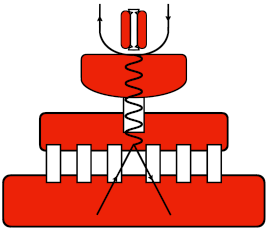Conveners
Present and Future of Flavor Physics
- Marco Stanislao Sozzi (INFN Sezione di Pisa, Universita' e Scuola Normale Superiore, P)
The Belle II experiment at the SuperKEKB energy-asymmetric $e^+ e^-$ collider is a substantial upgrade of the B factory facility at the Japanese KEK laboratory. The design luminosity of the machine is $8\times 10^{35}$ cm$^{-2}$s$^{-1}$ and the Belle II experiment aims to record 50 ab$^{-1}$ of data, a factor of 50 more than its predecessor. With this data set, Belle II will be able to measure...
KOTO (step-I) is the first experiment with the designed sensitivity of $O(10^{-11})$ to probe for new physics through the rare $K_L^0 \rightarrow \pi^0 \nu \bar{\nu}$ decay. In 2018-2019, there were critical changes in the detector and the data acquisition system that further improved the research potential of KOTO. One of the significant changes in the detector was the dual-sided readout...
We are searching for the decay $K_L\rightarrow \pi^0\nu\overline{\nu}$ in the KOTO experiment at J-PARC. The signal is identified by detecting two photons from the $\pi^0$ decay with a calorimeter composed of undoped CsI crystals. The main background “hadron cluster background” comes from neutrons generating two clusters in the calorimeter: a neutron in the beam halo hits the calorimeter to...
Precise measurements of the branching ratios (BRs) for the flavor-changing neutral current decays $K\to\pi\nu\bar{\nu}$ can provide unique constraints on CKM unitarity and, potentially, evidence for new physics. It is important to measure both decay modes, $K^+\to\pi^+\nu\bar{\nu}$ and $K_L\to\pi^0\nu\bar{\nu}$, since different new physics models affect the rates for each channel differently....
A next-generation experiment at J-PARC to measure the branching ratio of $K_L \rightarrow \pi^0 \nu \overline{\nu}$ is being considered. The currently-running experiment in the Hadron Experimental Facility (HEF) at J-PARC, the KOTO experiment, will reach a sensitivity level below $10^{-10}$ in 3-4 years but will take a much longer time toward the Standard Model (SM) sensitivity...
